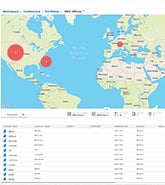Making the shift to cloud-based risk modeling and analytics sounds dramatic, a fundamental change for the (re)insurance industry from the familiar to a whole new world. But this whole new world is already here.
From an RMS® perspective, some of our clients have been using the Risk Modeler™ 2.0 application on our open, cloud-based risk analytics platform RMS Risk Intelligence™ for over a year now. What has their experience been, what are they using the Risk Modeler application for, and from a client’s perspective, has the shift to the cloud really been such a dramatic move?
Let’s provide some context to what has been a busy 12 months or so. Risk Modeler 2.0, our cloud-based modeling application, was released in June 2020. This launch then facilitated a wave of new high-definition (HD) models, all ready to take advantage of the platform, and by the end of September 2020, a total of seven HD Models™ were available.
These HD Models usher in a new generation of risk modeling and represent significant investment and development from RMS. Using the HD model framework to simulate tens of thousands of years of representative events helps explore the full extent of peril risk to deliver confidence for location-level risk analysis.
The HD Models launched included New Zealand Earthquake, Europe Inland Flood, along with Japan Earthquake and Tsunami, and Japan Typhoon and Flood. For the U.S., HD Models include North America Wildfire and U.S. Inland Flood. More HD Models for New Zealand Inland Flood, and Southeast Asia Inland Flood are rolling out, and together they offer a wealth of new modeling insight.
It would be easy to think that the Risk Modeler application is all about HD Models, but that is just part of the story. All the RMS aggregate loss models (ALM®) and detailed loss models (DLM) are available, all within a seamless, familiar modeling workflow. With parity to RiskLink® software, new major updates such as Version 21 flow into Risk Modeler 2.0, a complete modeling application.
Users Across the Globe and the Industry
We can now look at what has been happening with Risk Modeler application usage on the platform more than 12 months on. What has been evident, through our analysis on user traffic on the platform is that usage has grown at an exponential rate, and across all model types.
It is also interesting to see the locations of users. We see clients from across the world accessing the platform – from the U.S., Europe, Asia Pacific, Latin America – and from across the industry – whether it is primaries, brokers, or reinsurers. From small, agile businesses with a single analyst to the biggest names with dedicated teams in every corner of the world, users cover the whole spectrum of the (re)insurance industry.
What unites these users? There are many factors in play. They are certainly taking advantage of how easy it is to access the latest HD Models and are actively validating these models ahead of renewal seasons. The familiarity of the workflow makes HD model output easy to understand, and the speed and scale of the cloud platform makes model runs quick to execute.
Selecting and accessing new models does not require an on-premise install – just license and go – and validation is simpler as models can be run alongside each other. New views of risk are being explored, combining seismic and climatic perils for a region, to assess accumulation hot spots or opportunities.
Users are also doing their mainstream modeling on the Risk Modeler application, already accessing the latest Version 21 models, Version 18.1 models, as well as HD Models, ranging from Belgium Flood to Philippines Windstorm. So, rather than doing a grand “lift and shift” from on-premises modeling solutions such as RiskLink software, the change to cloud-based modeling has been more of an evolution. Clients are exploring new models, validating, and once teams are using the Risk Modeler app then more of their everyday modeling starts to switch over.
Continuing Innovation and New Features
We are asking clients for feedback and RMS continues to innovate, building out new features every six weeks for clients to immediately access with no downtime. One client’s comment shows just how mainstream the Risk Modeler app has become for their business:
“The Risk Modeler application offers us a convenient way to access an up-to-date view of modeled losses for peril regions such as U.S. wildfire, New Zealand earthquake, and Europe flood.”
It is very encouraging to see how clients are embracing the new HD Models and moving fast on their validation to ensure they get the latest view of risk ahead of renewals. Also, how clients are combining this work with the use of their ALM/DLM models.
In the last quarter, the number of HD analyses run by clients on the Risk Modeler app had increased by 80 percent on the previous quarter, quickly catching up to the number of DLM runs growing at 35 percent on the previous quarter. Clients are demonstrating just how easy it is to run these new models, and the speed, convenience, and simplicity of the modeling workflows are proving very attractive.
For clients contemplating the move from on-premises RiskLink software to the cloud-based Risk Modeler application, having instant access to Version 21 models without an install and accessing HD Models to move ahead with this new view of risk, together with accessing existing models, are proving to be triggers for adoption.
As we celebrate the first anniversary of the Risk Modeler 2.0 application, we would be happy to share our experience and that of our clients, about how cloud adoption is more evolution than revolution. Email our sales team to learn more.







